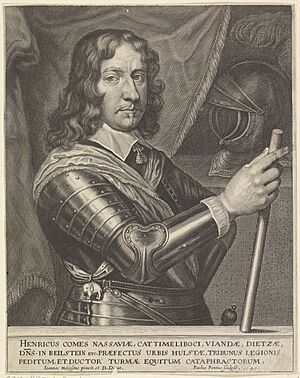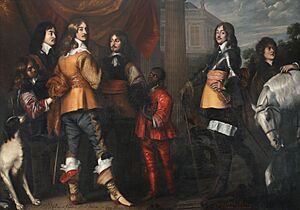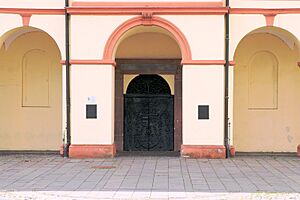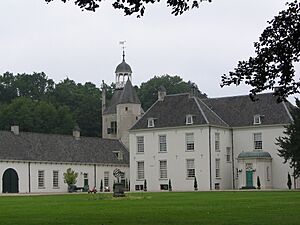Henry of Nassau-Siegen (1611–1652) facts for kids
Quick facts for kids
Henry of Nassau-Siegen
|
|
|---|---|

Count Henry of Nassau-Siegen. Print by Paulus Pontius after a painting by Joannes Meyssens. Rijksmuseum Amsterdam.
|
|
| Coat of arms |  |
| Full name |
Henry Count of Nassau-Siegen
|
| Native name | Heinrich Graf von Nassau-Siegen |
| Born | Heinrich Graf zu Nassau, Katzenelnbogen, Vianden und Diez, Herr zu Beilstein 9 August 1611 Siegen Castle |
| Baptised | 29 September 1611 Siegen Castle |
| Died | 7 November 1652 (aged 41) Hulst |
| Buried | Terborg reburied: 17 July 1669 in the Fürstengruft, Siegen |
| Noble family | House of Nassau-Siegen |
| Spouse(s) | Mary Magdalene of Limburg-Stirum |
| Issue Detail |
|
| Father | John VII 'the Middle' of Nassau-Siegen |
| Mother | Margaret of Schleswig-Holstein-Sonderburg |
| Occupation | Captain of the infantry in the Dutch States Army 1632, lieutenant colonel 1636, colonel 1647, governor of Hulst 1645–1652, diplomat for the Dutch Republic. |
Count Henry of Nassau-Siegen (born August 9, 1611 – died November 7, 1652) was a noble from the House of Nassau-Siegen. He was an important figure who worked for the Dutch Republic (which is now the Netherlands). He served as a diplomat (someone who represents their country in other nations), a military officer in the Dutch States Army, and even as the governor of a city called Hulst.
Contents
Henry's Life and Education
Henry was born at Siegen Castle on August 9, 1611. He was the fourth son of Count John VII and his second wife, Duchess Margaret of Schleswig-Holstein-Sonderburg. He was baptized at the same castle on September 29.
As a young boy, Henry received his education at royal courts. He studied at the court of the Electoral Palatinate in Heidelberg, Germany. He also spent time at the Bohemian court in Prague. When the "Winter King" (who was Elector Frederick V) had to leave Prague, Henry went with him to The Hague in the Netherlands. From September 14, 1623, Henry studied at Leiden University alongside the King's eldest son, Frederick Henry.
Serving the Netherlands

Henry began his military career in the Dutch States Army. On November 27, 1632, he became a captain of an infantry (foot soldiers) company. He quickly moved up the ranks, becoming a lieutenant colonel on January 2, 1636, and then a colonel on March 23, 1647. He also became a Rittmeister (a cavalry officer) on April 20, 1640.
Henry showed great bravery during the Eighty Years' War, a long conflict between the Netherlands and Spain. He was especially noted for his actions at the Siege of Gennep in 1641. He also served as the governor of Hulst starting in 1645.
The Dutch Republic often asked Henry to go on important diplomatic missions to other countries.
- In 1638, he traveled to Paris, France. There, he delivered congratulations from the States General of the Netherlands (the Dutch government) on the birth of the Dauphin of France (the future King Louis XIV). He also asked King Louis XIII to be a godparent for Prince Frederick Henry of Orange's son.
- In 1643, Henry went to Scandinavia. He attended a wedding in Stockholm, Sweden, and met his sister Amalia at the court of Queen Christina of Sweden. He also traveled to Danzig and Warsaw before returning to the Netherlands.
- In 1649, Henry went on another trip to the Nordic countries. For his service, he received a high honor called the Order of the Elephant from Denmark. The famous scientist Christiaan Huygens joined him on this trip as his secretary. Huygens wrote interesting stories about Henry's experiences at the Danish royal court. The Danish-Norwegian Queen Sophia Amalia even became the godmother for Henry's daughter, who was also named Sophia Amalia.
In 1652, Henry and his brothers John Maurice and George Frederick were witnesses at the wedding of Count William Frederick of Nassau-Dietz in Kleve.
Death and Burial
Henry passed away in Hulst on November 7, 1652. He was first buried in Terborg. Later, on July 17, 1669, his remains were moved and reburied in the family's special burial place, the Fürstengruft in Siegen.
Family Life and Children
Henry married Countess Mary Magdalene of Limburg-Stirum on April 29, 1646, at Wisch Castle in Terborg. Mary Magdalene was born in 1632 and died in Siegen on December 27, 1707. She was the only child of Count Georg Ernst of Limburg Stirum and his first wife. Mary Magdalene inherited several important lands and castles.
Henry and Mary Magdalene had four children:
- Ernestine (born 1647 – died 1652).
- William Maurice (born 1649 – died 1691). He later became a Fürst (Prince) of Nassau-Siegen, taking over from his uncle John Maurice in 1679.
- Sophie Amalie (born 1650 – died 1688). She married Duke Frederick Casimir of Courland.
- Frederick Henry (born 1651 – died 1676). He also became a colonel in the Dutch States Army.
After Henry's death, his sons William Maurice and Frederick Henry were adopted by their uncle, John Maurice of Nassau-Siegen. In 1664, William Maurice, Sophie Amalie, and Frederick Henry were given the special title of prince or princess.
Images for kids
Sources
|
Henry of Nassau-Siegen (1611–1652)
House of Nassau-Siegen (Protestant branch)
Born: 9 August 1611 Died: 27 October/7 November 1652 |
||
| Political offices | ||
|---|---|---|
| Preceded by Jacques d'Heynin |
Governor of Hulst 1645 – 1652 |
Succeeded by Gijsbrecht van Hardenbroek |




